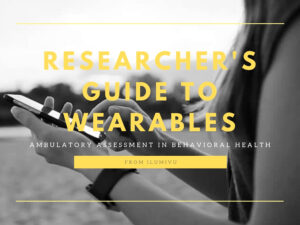
HRV Predicts Psychological and Biological Functioning
Heart rate variability (HRV) [1] – or the variation in number of heartbeats over a specific period of time – has been increasingly recognized as a predictor of psychological and biological dysfunction. Research has shown that lower HRV is associated with a host of health challenges. For instance, people with diseases ranging from diabetes [2] to major depression [3] are more likely to have lower HRV than healthy controls.
Lower HRV occurs in those who struggle with emotional regulation [4], appropriate social engagement, and psychological flexibility. On the other hand, children with higher HRV are more likely to have a secure attachment [5] style than those with lower HRV. Based on the link between HRV and behavioral and physical health, the value of HRV as a tool to predict outcomes and health-related events is becoming clearer.
Psychiatrists now know, for example, that an Army National Guard soldier who has a lower HRV before deployment is more likely to develop symptoms of PTSD [6]. Obstetricians and gynecologists have learned that women who undergo elective caesarean sections are more likely to develop hypotension [7] if they have lower HRV. HRV can also be used to predict the occurrence of things like ischemic stroke [8] and epileptic seizures [9].

HRV Used to Measure Intervention Efficacy
Just as HRV can be used to signal health risks, it can also indicate the efficacy of therapeutic interventions. For instance, while selective serotonin reuptake inhibitors (SSRIs) improve symptoms of depression and anxiety, they have been shown to normalize HRV. The normalization of HRV may therefore provide important information on the likelihood that a new intervention is benefiting a patient.
Ambulatory Assessment of HRV
It is hard to argue against the value of measuring HRV and in certain contexts, monitoring it as well. However, conventional methods of measuring HRV only during clinic visits limit the relevant data that can be collected and prevent meaningful predictions or interventions related to HRV. One way to improve the quality and volume of HRV data so that it can be put to use by healthcare providers is to use ecological momentary assessment [10] (EMA).
The value of EMA is that it allows for repeated sampling in real-time [11] and while subjects engage in their natural environments rather than in laboratory settings where they are less likely to act as they would outside of the lab. This approach is therefore ecologically valid and enables the study of microprocesses affecting behavioral and physical health.
One limitation of some EMA methods is that they may require that patients measure and record activity, which may lead to data errors or omissions. Indeed, in the case of HRV, measuring poses certain challenges[12]. EMA may also be subject to several forms of bias if, for instance, patients retroactively record pieces of information.
When tracking HRV, integrating ambulatory assessment with EMA may offer a way to overcome some weaknesses of using EMA methods alone. Ambulatory assessment involves a more continuous collection of data related to physiological states [13]. This method has become increasingly popular in recent years because it not only allows for ecological validity but also minimizes retrospective bias. When combined, ambulatory assessment data and EMA data can provide powerful insights into a patient’s HRV and how their HRV may impact their overall health.
Technological Advances in HRV and EMA
Technological innovation has spurred the incorporation of ambulatory assessment into EMA studies. It is getting easier and easier to continuously track physiological data with the use of technologies like wearables and mobile apps. The result is that clinicians can look at a combination of physiological data and self-report data and develop a much richer understanding of a patient’s health and what influences the patient’s physiology. Given that HRV appears to be a biomarker for a spectrum of health-related issues but its role in behavioral and physical health is not precisely defined, a combination of EMA and ambulatory assessment may be particularly fruitful from not only a clinical standpoint but also a research standpoint.
While the ability to capture real-time data represents a huge step forward in medicine, the technology that has supported this type of data collection has not always optimized the user experience for either the patient or the clinician. As awareness of the value of ambulatory assessment and EMA integration has grown, so too has demand for the relevant technology. In addition, as people have begun using these technologies more and more, our understanding of how to optimize them has also deepened.
It is valuable, for instance, to have timestamps for each data point and for patients and clinicians to be able to use technology to communicate. Luckily, companies with a keen understanding of how to best capture physiological data and how best to convey that information to both patients and clinicians are incorporating user experience into their design and creating wearables and apps that better support the use of the HRV biomarker in medical practice.
Ilumivu has been providing Ecological Momentary Assessment software to researchers since 2009. Their mobile EMA app (mEMA) integrates with various wearable devices to provide ambulatory assessment of HRV, HR, Steps, Calories and other biometrics relevant to behavioral health research.

References
[1] https://www.ncbi.nlm.nih.gov/pmc/articles/PMC5622597/
[2] https://www.ncbi.nlm.nih.gov/pubmed/31062488
[3] https://www.ncbi.nlm.nih.gov/pubmed/31239003
[4] https://www.ncbi.nlm.nih.gov/pubmed/26004818
[5] https://www.nature.com/articles/s41598-019-41812-y
[6] https://www.ncbi.nlm.nih.gov/pubmed/27773678
[7] https://www.ncbi.nlm.nih.gov/pubmed/28133720
[8] https://www.frontiersin.org/articles/10.3389/fneur.2018.00090/full
[9] https://www.ncbi.nlm.nih.gov/pubmed/28127975
[10] https://www.ncbi.nlm.nih.gov/pubmed/18509902
[11] http://jpn.ca/vol31-issue1/31-1-13/
[12] https://hrvcourse.com/the-8-biggest-mistakes-made-when-measuring-hrv/
